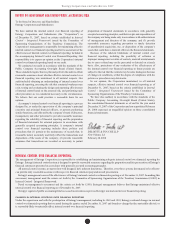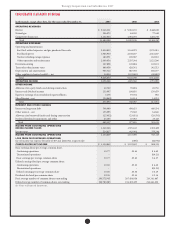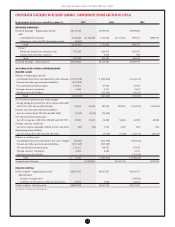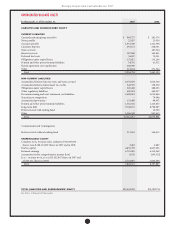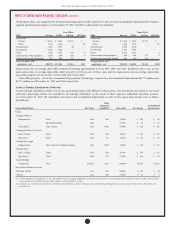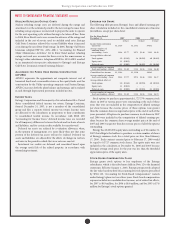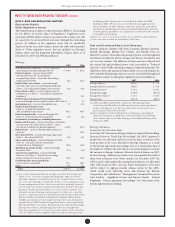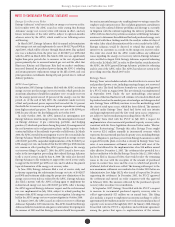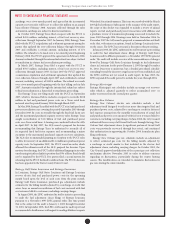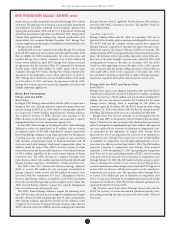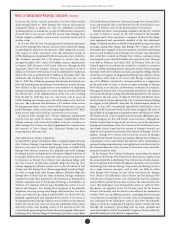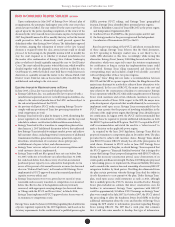Entergy 2007 Annual Report Download - page 65
Download and view the complete annual report
Please find page 65 of the 2007 Entergy annual report below. You can navigate through the pages in the report by either clicking on the pages listed below, or by using the keyword search tool below to find specific information within the annual report.
63
Entergy Corporation and Subsidiaries 2007
Notes to Consolidated Financial Statements continued
AP P L I C AT I O N O F SFAS 71
Entergy’s Utility operating companies and System Energy currently
account for the eects of regulation pursuant to SFAS 71, “Accounting
for the Eects of Certain Types of Regulation.” is statement applies to
the nancial statements of a rate-regulated enterprise that meets three
criteria. e enterprise must have rates that (i) are approved by a body
empowered to set rates that bind customers (its regulator); (ii) are cost-
based; and (iii) can be charged to and collected from customers. ese
criteria may also be applied to separable portions of a utility’s business,
such as the generation or transmission functions, or to specic classes
of customers. If an enterprise meets these criteria, it capitalizes costs
that would otherwise be charged to expense if the rate actions of its
regulator make it probable that those costs will be recovered in future
revenue. Such capitalized costs are reected as regulatory assets in
the accompanying nancial statements. SFAS 71 requires that rate-
regulated enterprises continue to assess the probability of recovering
their regulatory assets. When an enterprise concludes that recovery of
a regulatory asset is no longer probable, the regulatory asset must be
removed from the entity’s balance sheet.
SFAS 101, “Accounting for the Discontinuation of Application of
FASB Statement No. 71,” species how an enterprise that ceases to meet
the criteria for application of SFAS 71 for all or part of its operations
should report that event in its nancial statements. In general, SFAS
101 requires that the enterprise report the discontinuation of the
application of SFAS 71 by eliminating from its balance sheet all
regulatory assets and liabilities related to the applicable operations.
Additionally, if it is determined that a regulated enterprise is no longer
recovering all of its costs and therefore no longer qualies for SFAS
71 accounting, it is possible that an impairment may exist that could
require further write-os of plant assets.
FASB’s Emerging Issues Task Force (EITF) 97-4: “Deregulation
of the Pricing of Electricity - Issues Related to the Application of
FASB Statements No. 71 and 101” species that SFAS 71 should be
discontinued at a date no later than when the eects of a transition to
competition plan for all or a portion of the entity subject to such plan
are reasonably determinable. Additionally, EITF 97-4 promulgates
that regulatory assets to be recovered through cash ows derived from
another portion of the entity that continues to apply SFAS 71 should
not be written o; rather, they should be considered regulatory assets
of the portion of the entity that will continue to apply SFAS 71.
See Note 2 to the nancial statements for discussion of transition
to competition activity in the retail regulatory jurisdictions served by
Entergy’s Utility operating companies.
CA S H A N D CA S H EQ U I V A L E N T S
Entergy considers all unrestricted highly liquid debt instruments with
an original or remaining maturity of three months or less at date of
purchase to be cash equivalents. Investments with original maturities of
more than three months are classied as other temporary investments
on the balance sheet.
IN V E S T M E N T S
Entergy applies the provisions of SFAS 115, “Accounting for Investments
for Certain Debt and Equity Securities,” in accounting for investments
in decommissioning trust funds. As a result, Entergy records the
decommissioning trust funds on the balance sheet at their fair value.
Because of the ability of the Utility operating companies and System
Energy to recover decommissioning costs in rates and in accordance
with the regulatory treatment for decommissioning trust funds,
the Utility operating companies and System Energy have recorded
an osetting amount of unrealized gains/(losses) on investment
securities in other regulatory liabilities/assets. For the nonregulated
portion of River Bend, Entergy Gulf States Louisiana has recorded
an osetting amount of unrealized gains/(losses) in other deferred
credits. Decommissioning trust funds for Pilgrim, Indian Point 2,
Vermont Yankee, and Palisades do not receive regulatory treatment.
Accordingly, unrealized gains recorded on the assets in these trust
funds are recognized in the accumulated other comprehensive income
component of shareholders’ equity because these assets are classied
as available for sale. Unrealized losses (where cost exceeds fair market
value) on the assets in these trust funds are also recorded in the
accumulated other comprehensive income component of shareholders’
equity unless the unrealized loss is other than temporary and therefore
recorded in earnings. e assessment of whether an investment has
suered an other than temporary impairment is based on a number
of factors including, rst, whether Entergy has the ability and intent
to hold the investment to recover its value, the duration and severity
of any losses, and, then, whether it is expected that the investment will
recover its value within a reasonable period of time. See Note 17 to the
nancial statements for details on the decommissioning trust funds.
EQ U I T Y ME T H O D IN V E S T E E S
Entergy owns investments that are accounted for under the equity
method of accounting because Entergy’s ownership level results
in signicant inuence, but not control, over the investee and its
operations. Entergy records its share of earnings or losses of the investee
based on the change during the period in the estimated liquidation
value of the investment, assuming that the investee’s assets were to be
liquidated at book value. In accordance with this method, earnings
are allocated to owners or members based on what each partner
would receive from its capital account if, hypothetically, liquidation
were to occur at the balance sheet date and amounts distributed were
based on recorded book values. Entergy discontinues the recognition
of losses on equity investments when its share of losses equals or
exceeds its carrying amount for an investee plus any advances made or
commitments to provide additional nancial support. See Note 14 to
the nancial statements for additional information regarding Entergy’s
equity method investments.
DE R I VAT I V E FI N A N C I A L IN S T R U M E N T S A N D
CO M M O D I T Y DE R I VAT I V E S
SFAS 133, “Accounting for Derivative Instruments and Hedging Activities,”
requires that all derivatives be recognized in the balance sheet, either as
assets or liabilities, at fair value, unless they meet the normal purchase,
normal sales criteria. e changes in the fair value of recognized derivatives
are recorded each period in current earnings or other comprehensive
income, depending on whether a derivative is designated as part of a hedge
transaction and the type of hedge transaction.
Contracts for commodities that will be delivered in quantities
expected to be used or sold in the ordinary course of business, including
certain purchases and sales of power and fuel, are not classied as
derivatives. ese contracts are exempted under the normal purchase,
normal sales criteria of SFAS 133. Revenues and expenses from these
contracts are reported on a gross basis in the appropriate revenue and
expense categories as the commodities are received or delivered.
For other contracts for commodities in which Entergy is hedging
the variability of cash ows related to a variable-rate asset, liability,
or forecasted transactions that qualify as cash ow hedges, the
changes in the fair value of such derivative instruments are reported
in other comprehensive income. To qualify for hedge accounting, the
relationship between the hedging instrument and the hedged item
must be documented to include the risk management objective and
strategy and, at inception and on an ongoing basis, the eectiveness of
the hedge in osetting the changes in the cash ows of the item being


